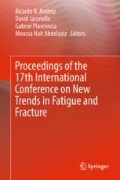Abstract
This study presents a peridynamic modeling approach to predict damage initiation and growth in fiber-reinforced Ceramic Matrix Composites (CMC). Damage prediction is based on the critical stretch which is directly related to the strain energy release rate failure criteria. The capability of this approach is verified against benchmark solutions and experimental observations available in the literature. A new nonuniform discretization capability in peridynamics is applied to investigate crack propagation in CMCs in the presence of a fairly dense matrix, and with fine discretization of the interphase (coating) regions. In the presence of a weak interphase between the fibers and matrix, it predicts the propagation of cracks through the dense matrix while deflecting around the fibers through the interphase region.
Access this chapter
Tax calculation will be finalised at checkout
Purchases are for personal use only
References
F. Rebillat, J. Lamon, A. Guette. The concept of a strong interface applied to SiC/SiC composites with a BN interphase. Acta Material, 2000, Vol. 48, 4609–4618.
E. Martin, D. Leguillon. Energetic conditions for interfacial failure in ther vicinity of a matrix crack in brittle matrix composites. Int. J. of Solids and Structure, 2004, Vol. 41, 6937–6948.
P.S. Theocaris, J. Milios. Disruption of a longitudinal interface by a moving transverse crack. J. of Reinforced Plastic Composites, 1983, Vol. 2, 18–28.
N.J. Pagano, H.W. Brown. The full-cell cracking mode in unifirectional brittle-matrix composites. Composites, 1993, Vol. 24, 69–83.
W. Lee, S.J. Howard, W.J. Clegg. Growth of interface defects and its effect on crack deflection and toughening criteria. Acta Material, 1996, Vol. 44, 3905–3922.
Y. Kagawa, K. Goto. Direct observation and modeling of the crack-fibre interaction process in continuous fibre-reinforced ceramics: model experiment. Material Science Engineering A, 1998, Vol. 250, 285–290.
J. Cook, J. E. Gordon, C. C. Evans and D. M. Marsh, A mechanism for the control of crack propagation in all-brittle systems. Proc. of the Royal Society of London. Series A, Mathematical and Physical Sciences, 1964, Vol. 282, 508–520.
M. Braginsky, C.P. Przybyla. Simulation of crack propagation/deflection in ceramic matrix continuous fiber reinforced composites with weak interphase via the extended finite element method. Composite Structures, 2016, Vol. 136, 538–545.
S.A. Silling. Reformulation of elasticity theory for discontinuities and long-range forces. J Mech Phys Solids, 2000, Vol. 48, 175–209.
S.A. Silling, M. Epton, O. Weckner, J. Xu, E Askari, Peridynamics states and constitutive modeling, J. Elasticity, 2007, Vol. 88, 151–184.
S.A. Silling, R.B. Lehoucq. Peridynamic theory of solid mechanics. Adv. Appl. Mech., 2010, Vol. 44, 73–168.
S.A. Silling, E. Askari, A meshfree method based on the peridynamic model of solid mechanics, Comput. Struct. 2005, Vol. 83, 1526–1535.
E. Madenci, E. Oterkus, Peridynamic Theory and Its Applications, Springer, New York, 2014.
D. Dunn. The effect of fiber volume fraction in HiPerComp SiC-SiC composites, PhD Thesis, Alfred University, Alfred, New York, 2010.
Author information
Authors and Affiliations
Corresponding author
Editor information
Editors and Affiliations
Rights and permissions
Copyright information
© 2018 Springer International Publishing AG
About this paper
Cite this paper
Hu, Y., Madenci, E., Phan, N. (2018). Peridynamic Modeling of Cracking in Ceramic Matrix Composites. In: Ambriz, R., Jaramillo, D., Plascencia, G., Nait Abdelaziz, M. (eds) Proceedings of the 17th International Conference on New Trends in Fatigue and Fracture. NT2F 2017. Springer, Cham. https://doi.org/10.1007/978-3-319-70365-7_40
Download citation
DOI: https://doi.org/10.1007/978-3-319-70365-7_40
Published:
Publisher Name: Springer, Cham
Print ISBN: 978-3-319-70364-0
Online ISBN: 978-3-319-70365-7
eBook Packages: Chemistry and Materials ScienceChemistry and Material Science (R0)

